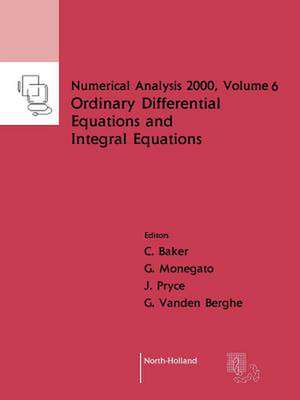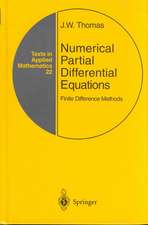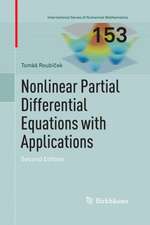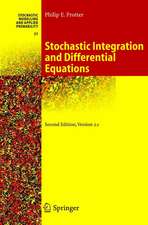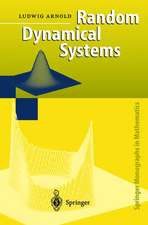Ordinary Differential Equations and Integral Equations: Numerical Analysis 2000, cartea 6
Autor C.T.H. Baker, G. Monegato, G. Vanden Berghe Editat de J.D. Pryceen Limba Engleză Paperback – 19 iun 2001
/homepage/sac/cam/na2000/index.html7-Volume Set now available at special set price !
This volume contains contributions in the area of differential equations and integral equations. Many numerical methods have arisen in response to the need to solve "real-life" problems in applied mathematics, in particular problems that do not have a closed-form solution. Contributions on both initial-value problems and boundary-value problems inordinary differential equationsappear in this volume. Numerical methods forinitial-value problemsin ordinary differential equations fall naturally into two classes: those which useonestarting value at each step (one-step methods) and those which are based onseveralvalues of the solution (multistep methods).
John Butcher has supplied an expert's perspective of the development of numerical methods for ordinary differential equations in the 20th century.
Rob Corless and Lawrence Shampine talk about established technology, namely software for initial-value problems using Runge-Kutta and Rosenbrock methods, with interpolants to fill in the solution between mesh-points, but the 'slant' is new - based on the question, "How should such software integrate into the current generation ofProblem Solving Environments?"
Natalia Borovykh and Marc Spijker study the problem of establishing upper bounds for the norm of thenth power of square matrices.
The dynamical system viewpoint has been of great benefit to ODE theory and numerical methods. Related is the study ofchaotic behaviour.
Willy Govaerts discusses the numerical methods for the computation and continuation of equilibria and bifurcation points of equilibria of dynamical systems.
Arieh Iserles and Antonella Zanna survey the construction of Runge-Kutta methods which preserve algebraic invariant functions.
Valeria Antohe and Ian Gladwell present numerical experiments on solving a Hamiltonian system of Hénon and Heiles with a symplectic and a nonsymplectic method with a variety of precisions and initial conditions.
Stiff differential equationsfirst became recognized as special during the 1950s. In 1963 two seminal publications laid to the foundations for later development: Dahlquist's paper onA-stable multistep methods and Butcher's first paper on implicit Runge-Kutta methods.
Ernst Hairer and Gerhard Wanner deliver a survey which retraces the discovery of the order stars as well as the principal achievements obtained by that theory.
Guido Vanden Berghe, Hans De Meyer, Marnix Van Daele and Tanja Van Hecke construct exponentially fitted Runge-Kutta methods withsstages.
Differential-algebraic equationsarise in control, in modelling of mechanical systems and in many other fields.
Jeff Cash describes a fairly recent class of formulae for the numerical solution of initial-value problems forstiff and differential-algebraic systems.
Shengtai Li and Linda Petzold describe methods and software forsensitivity analysisof solutions of DAE initial-value problems.
Again in the area of differential-algebraic systems, Neil Biehn, John Betts, Stephen Campbell and William Huffman present current work on mesh adaptation for DAE two-point boundary-value problems.
Contrasting approaches to the question of how good an approximation is as a solution of a given equation involve (i) attempting to estimate the actualerror(i.e., the difference between the true and the approximate solutions) and (ii) attempting to estimate thedefect- the amount by which the approximation fails to satisfy the given equation and any side-conditions.
The paper by Wayne Enright on defect control relates to carefully analyzed techniques that have been proposed both for ordinary differential equations and for delay differential equations in which an attempt is made to control an estimate of the size of the defect.
Many phenomena incorporate noise, and the numerical solution ofstochastic differential equationshas developed as a relatively new item of study in the area.
Keven Burrage, Pamela Burrage and Taketomo Mitsui review the way numerical methods for solving stochastic differential equations (SDE's) are constructed.
One of the more recent areas to attract scrutiny has been the area ofdifferential equations with after-effect(retarded, delay, or neutral delay differential equations) and in this volume we include a number of papers on evolutionary problems in this area.
The paper of Genna Bocharov and Fathalla Rihan conveys the importance in mathematical biology of models using retarded differential equations.
The contribution by Christopher Baker is intended to convey much of the background necessary for the application of numerical methods and includes some original results on stability and on the solution of approximating equations.
Alfredo Bellen, Nicola Guglielmi and Marino Zennaro contribute to the analysis of stability of numerical solutions of nonlinear neutral differential equations.
Koen Engelborghs, Tatyana Luzyanina, Dirk Roose, Neville Ford and Volker Wulf consider the numerics of bifurcation in delay differential equations.
Evelyn Buckwar contributes a paper indicating the construction and analysis of a numerical strategy for stochastic delay differential equations (SDDEs).
This volume contains contributions on bothVolterra and Fredholm-type integral equations.
Christopher Baker responded to a late challenge to craft a review of the theory of the basic numerics of Volterra integral and integro-differential equations.
Simon Shaw and John Whiteman discuss Galerkin methods for a type of Volterra integral equation that arises in modelling viscoelasticity.
A subclass ofboundary-value problemsfor ordinary differential equation compriseseigenvalue problemssuch as Sturm-Liouville problems (SLP) and Schrödinger equations.
Liviu Ixaru describes the advances made over the last three decades in the field of piecewise perturbation methods for the numerical solution of Sturm-Liouville problems in general and systems of Schrödinger equations in particular.
Alan Andrew surveys the asymptotic correction method for regular Sturm-Liouville problems.
Leon Greenberg and Marco Marletta survey methods for higher-order Sturm-Liouville problems.
R. Moore in the 1960s first showed the feasibility ofvalidated solutionsof differential equations, that is, of computing guaranteed enclosures of solutions.
Boundary integral equations. Numerical solution of integral equations associated with boundary-value problems has experienced continuing interest.
Peter Junghanns and Bernd Silbermann present a selection of modern results concerning the numerical analysis of one-dimensional Cauchy singular integral equations, in particular the stability of operator sequences associated with different projection methods.
Johannes Elschner and Ivan Graham summarize the most important results achieved in the last years about the numerical solution of one-dimensional integral equations of Mellin type of means of projection methods and, in particular, by collocation methods.
A survey of results on quadrature methods for solving boundary integral equations is presented by Andreas Rathsfeld.
Wolfgang Hackbusch and Boris Khoromski present a novel approach for a very efficient treatment of integral operators.
Ernst Stephan examines multilevel methods for theh-, p-andhp-versions of the boundary element method, including pre-conditioning techniques.
George Hsiao, Olaf Steinbach and Wolfgang Wendland analyze various boundary element methods employed in local discretization schemes.
Preț: 758.75 lei
Preț vechi: 1039.38 lei
-27% Nou
Puncte Express: 1138
Preț estimativ în valută:
145.21€ • 151.04$ • 119.88£
145.21€ • 151.04$ • 119.88£
Carte tipărită la comandă
Livrare economică 14-28 aprilie
Preluare comenzi: 021 569.72.76
Specificații
ISBN-13: 9780444506009
ISBN-10: 0444506004
Pagini: 558
Dimensiuni: 210 x 279 x 29 mm
Greutate: 1.24 kg
Editura: ELSEVIER SCIENCE
Seria Numerical Analysis 2000
ISBN-10: 0444506004
Pagini: 558
Dimensiuni: 210 x 279 x 29 mm
Greutate: 1.24 kg
Editura: ELSEVIER SCIENCE
Seria Numerical Analysis 2000
Cuprins
Preface.
Numerical
methods
for
ordinary
differential
equations
in
the
20th
century
(J.C.
Butcher).
Initial
value
problems
for
ODE's
in
problem
solving
environments
(L.F.
Shampine,
R.M.
Corless).
Resolvent
conditions
and
bounds
on
the
powers
of
matrices,
with
relevance
to
numerical
stability
of
initial
value
problems
(N.
Borovykh,
M.N.
Spijker).
Numerical
bifurcation
analysis
for
ODEs
(W.
Govaerts).
Preserving
algebraic
invariants
with
Runge-Kutta
methods
(A.
Iserles,
A.
Zanna).
Performance
of
two
methods
for
solving
separable
Hamiltonian
systems
(V.
Antohe,
I.
Gladwell).
Order
stars
and
stiff
integrators
(E.
Hairer,
G.
Wanner).
Exponentially
fitted
Runge-Kutta
methods
(G.
Vanden
Berghe,
H.
De
Meyer,
M.
Van
Daele,
T.
Van
Hecke).
Modified
extended
backward
differentiation
formulae
for
the
numerical
solution
of
stiff
initial
value
problems
in
ODEs
and
DAEs
(J.R.
Cash).
Software
and
algorithms
for
sensitivity
analysis
of
large-scale
differential
algebraic
systems
(S.
Li,
L.
Petzold).
Compensating
for
order
variation
in
mesh
refinement
for
direct
transcription
methods
(J.T.
Betts,
N.
Biehn,
S.L.
Campbell,
W.P.
Huffman).
Continuous
numerical
methods
for
ODEs
with
defect
control
(W.H.
Enright).
Numerical
solutions
of
stochastic
differential
equations
-
implementations
and
stability
issues
(K.
Burrage,
P.
Burrage,
T.
Mitsui).
Numerical
modelling
in
biosciences
using
delay
differential
equations
(G.A.
Bocharov,
F.A.
Rihan).
Dynamics
of
constrained
differential
delay
equations
(J.
Norbury,
R.E.
Wilson).
A
perspective
on
the
numerical
treatment
of
Volterra
equations
(C.T.H.
Baker)
Numerical
stability
of
nonlinear
delay
differential
equations
of
neutral
type
(A.
Bellen,
N.
Guglielmi,
M.
Zennaro).
Numerical
bijurcation
analysis
of
delay
differential
equations
(K.
Engelborghs,
T.
Luzyanina,
D.
Roose).
How
do
numerical
methods
perform
for
delay
differential
equations
undergoing
a
Hopf
bifurcation?
(N.J.
Ford,
V.
Wulf).
Designing
efficient
software
for
solving
delay
differential
equations
(C.A.H.
Paul).
Introduction
to
the
numerical
analysis
of
stochastic
delay
differential
equations
(E.
Buckwar).
Retarded
differential
equations
(C.T.H.
Baker).
Adaptive
space-time
finite
element
solution
for
Volterra
equations
arising
in
viscoelasticity
problems
(S.
Shaw,
J.R.
Whiteman).
CP
methods
for
the
Schrödinger
equation
(L.Gr.
Ixaru).
Asymptotic
correction
of
Numerov's
eigenvalue
estimates
with
natural
boundary
conditions
(A.L.
Andrew).
Numerical
methods
for
higher
order
Sturm-Liouville
problems
(L.
Greenberg,
M.
Marletta).
On
a
comuter
assisted
proof
of
the
existence
of
eigenvalues
below
the
essential
spectrum
of
the
Sturm-Liouville
problem
(B.M.
Brown,
D.K.R.
McCormack,
A.
Zettl).
Numerical
analysis
for
non-dimensional
Cauchy
singular
integral
equations
(P.
Junghanns,
B.
Silbermann).
Numerical
methods
for
integral
equations
of
Mellin
type
(J.
Elschner,
I.G.
Graham).
Quadrature
methods
for
2D
and
3D
problems
(A.
Rathsfeld).
Qualocation
(I.H.
Sloan).
A
sparseH-matrix
arithmetic:
general
complexity
estimates
(W.
Hackbusch,
B.N.
Khoromskij)
Multilevel
methods
for
theh-,
p-,andhp-versions
of
the
boundary
element
method
(E.P.
Stephan).
Domain
decomposition
methods
via
boundary
integral
equations
(G.C.
Hsiao,
O.
Steinback,
W.L.
Wendland).
Author
Index
Volume
125.
